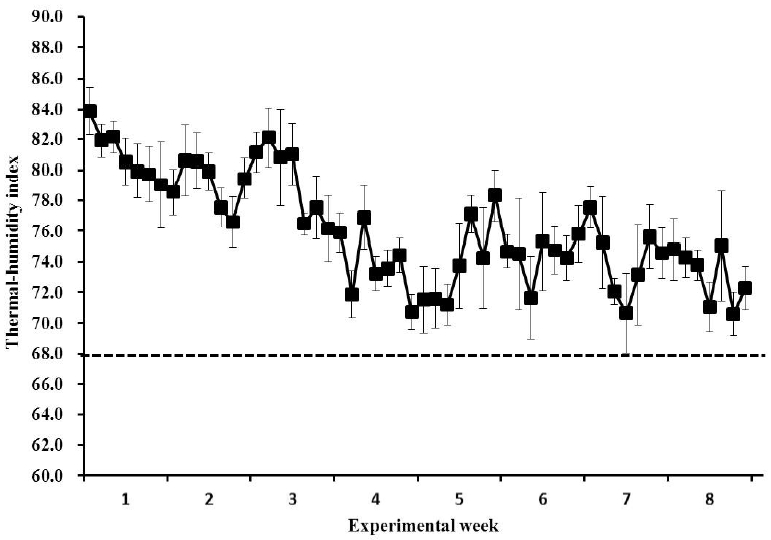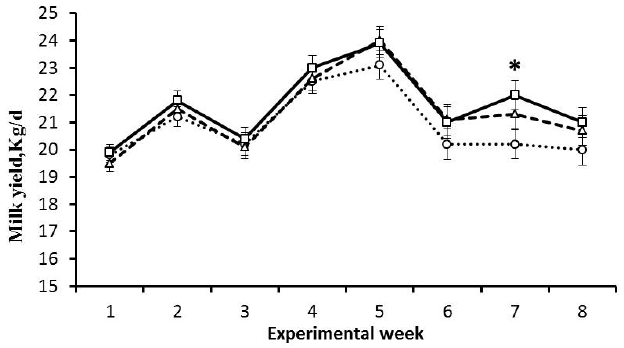AOAC. 2012. Official Methods of Analysis. 17th ednAssociation of Official Analytical Chemists; Arlington, VA, USA:
Arambel MJ, Kent BA. 1990. Effect of yeast culture on nutrient digestibility and milk yield response in early- to midlactation dairy cows. J Dairy Sci 73:1560–1563.


Baumgard LH, Wheelock JB, Shwartz G, O’Brien M, VanBaale MJ, Collier RJ, Rhoads ML, Rhoads RP. 2006. Effects of heat stress on nutritional requirements of lactating dairy cattle. In : Proceedings of the 5th Annual Arizona Dairy Production Conference; The University of Arizona; Arizona, UT, USA: p. 8–16.
Berman A, Folman Y, Kaim M, Mamen M, Herz Z, Wolfenson D, Arieli A, Graber Y. 1985. Upper critical temperatures and forced ventilation effects for high-yielding dairy cows in a subtropical climate. J Dairy Sci 68:1488–1495.


Burgos-Zimbelman R, Collier RJ. 2011. Feeding strategies for high-producing dairy cows during periods of elevated heat and humidity. In : Tri-State Dairy Nutrition Conference; Fort Wayne, IN, USA. p. 111–126.
Callaway ES, Martin SA. 1997. Effects of a
Saccharomyces cerevisiae culture on ruminal bacteria that utilize lactate and digest cellulose. J Dairy Sci 80:2035–2044.


Collier RJ, Dahl GE, VanBaale MJ. 2006. Major advances associated with environmental effects on dairy cattle. J Dairy Sci 89:1244–1253.


Edmonson AJ, Lean IJ, Weaver LD, Farver T, Webster G. 1989. A body condition scoring chart for Holstein dairy cows. J Dairy Sci 72:68–78.

Harrison GA, Hemken RW, Dawson KA, Harmon RJ, Barber KB. 1988. Influence of addition of yeast culture supplement to diets of lactating cows on ruminal fermentation and microbial populations. J Dairy Sci 71:2967–2975.


Mao HL, Mao HL, Wang JK, Liu JX, Yoon I. 2013. Effects of
Saccharomyces cerevisiae fermentation product on
in vitro fermentation and microbial communities of low-quality forages and mixed diets. J Anim Sci 91:3291–3298.


MOA (Ministry of Agriculture, China). 2004. Feeding Standard of Dairy Cattle (NY/T 34-2004). Beijing, China:
NOAA (National Oceanic and Atmospheric Administration). 1976. Livestock hot weather stress. US Dept. Commerce, Natl. Weather Serv. Central Reg., Reg. Operations Manual Lett. C-31–76.
NRC (Nutrient Requirents of Dairy Cattle). 2001. Nutrient Requirements of Dairy Cattle. 7th rev edNatl Acad Sci; Washington, DC, USA:
Poppy GD, Rabiee AR, Lean IJ, Sanchez WK, Dorton KL, Morley PS. 2012. A meta-analysis of the effects of feeding yeast culture produced by anaerobic fermentation of
Saccharomyces cerevisiae on milk production of lactating dairy cows. J Dairy Sci 95:6027–6041.


SAS Institute. 2000. SAS User’s Guide. Statistics, Version 8.01. SAS Inst, Inc; Cary, NC, USA:
Schingoethe DJ, Linke KN, Kalscheur KF, Hippen AR, Rennich DR, Yoon I. 2004. Feed efficiency of mid-lactation dairy cows fed yeast culture during summer. J Dairy Sci 87:4178–4181.


Shwartz G, Rhoads ML, VanBaale MJ, Rhoads RP, Baumgard LH. 2009. Effects of a supplemental yeast culture on heat-stressed lactating Holstein cows. J Dairy Sci 92:935–942.


St-Pierre NR, Cobanov B, Schnitkey G. 2003. Economic losses from heat stress by US livestock industries. J Dairy Sci 86:E SupplE52–E77.

Van Soest PJ, Robertson JB, Lewis BA. 1991. Methods for dietary fiber, neutral detergent fiber, and nonstarch polysaccharides in relation to animal nutrition. J Dairy Sci 74:3583–3597.


Wang JQ. 2006. Modern Dairy Production Science. China Agricultural Press; Beijing, China: (In Chinese)
Yoon I, Garrett JE. 1998. Yeast culture and processing effects on 24-hour
in situ ruminal degradation of corn silage. In : Proc. 8th World Conf. Anim. Prod.; Seoul, Korea. 1:p. 322–323. Seoul National University; Seoul, South Korea:

Zhang RY, Yoon I, Zhu WY, Mao SY. 2013. Effect of
Saccharomyces cerevisiae fermentation product on lactation performance and lipopolysaccharide concentration of dairy cows. Asian Australas J Anim Sci 26:1137–1143.












 PDF Links
PDF Links PubReader
PubReader ePub Link
ePub Link Full text via DOI
Full text via DOI Download Citation
Download Citation Print
Print





